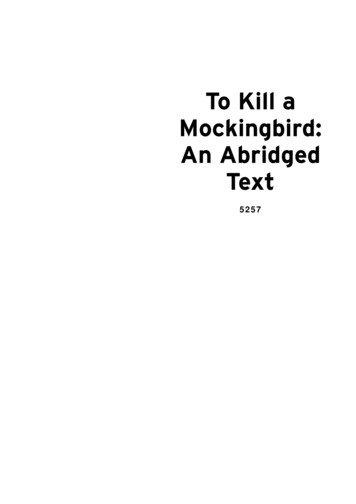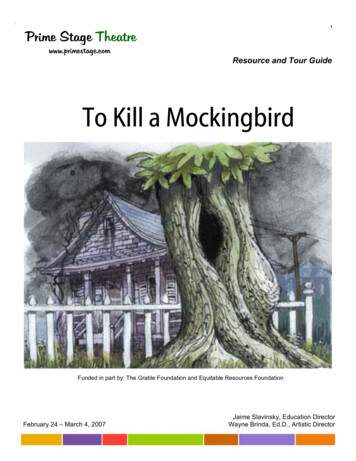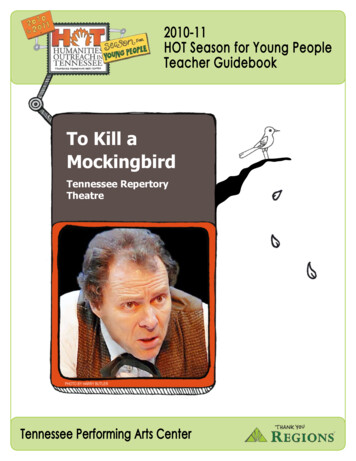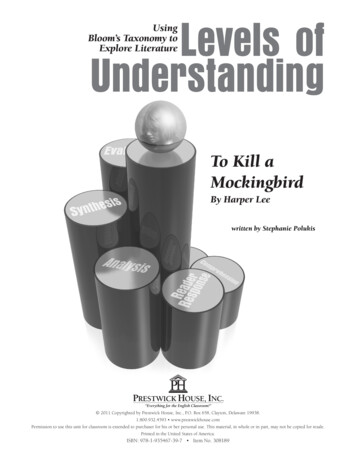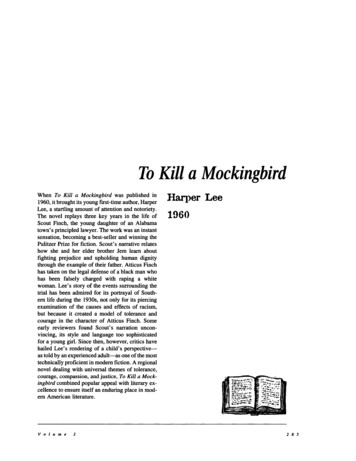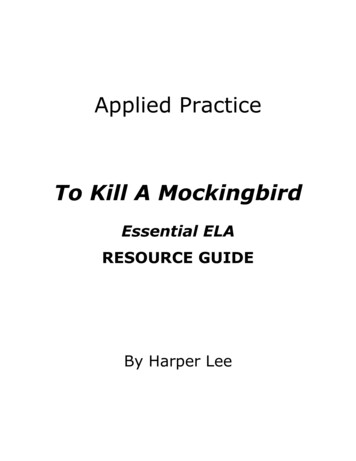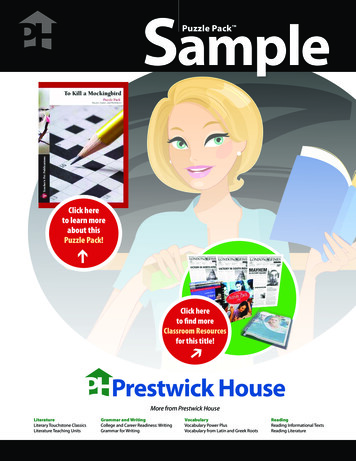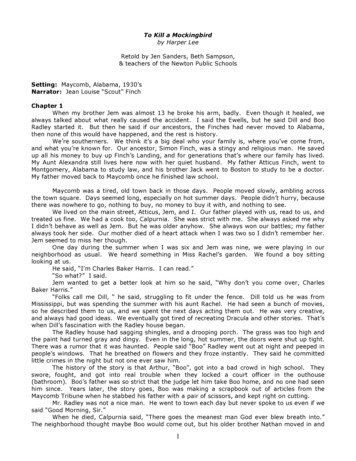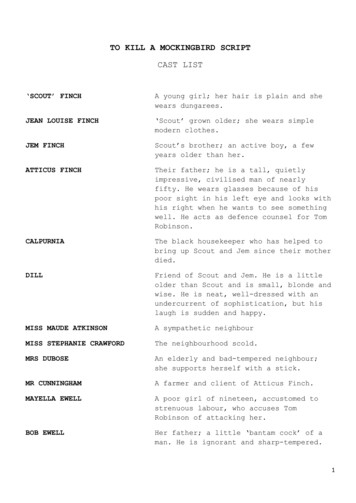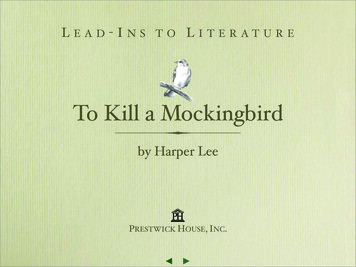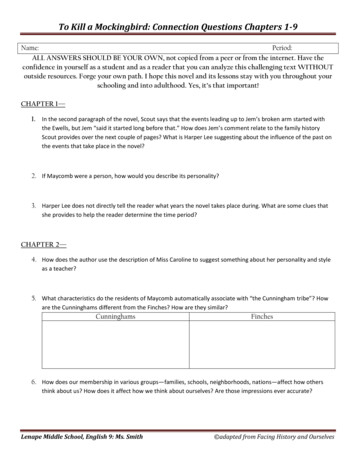
Transcription
To Kill a Mockingbird: Connection Questions Chapters 1-9Name:Period:ALL ANSWERS SHOULD BE YOUR OWN, not copied from a peer or from the internet. Have theconfidence in yourself as a student and as a reader that you can analyze this challenging text WITHOUToutside resources. Forge your own path. I hope this novel and its lessons stay with you throughout yourschooling and into adulthood. Yes, it’s that important!CHAPTER 1—1. In the second paragraph of the novel, Scout says that the events leading up to Jem’s broken arm started withthe Ewells, but Jem “said it started long before that.” How does Jem’s comment relate to the family historyScout provides over the next couple of pages? What is Harper Lee suggesting about the influence of the past onthe events that take place in the novel?2. If Maycomb were a person, how would you describe its personality?3. Harper Lee does not directly tell the reader what years the novel takes place during. What are some clues thatshe provides to help the reader determine the time period?CHAPTER 2—4. How does the author use the description of Miss Caroline to suggest something about her personality and styleas a teacher?5. What characteristics do the residents of Maycomb automatically associate with “the Cunningham tribe”? Howare the Cunninghams different from the Finches? How are they similar?CunninghamsFinches6. How does our membership in various groups—families, schools, neighborhoods, nations—affect how othersthink about us? How does it affect how we think about ourselves? Are those impressions ever accurate?Lenape Middle School, English 9: Ms. Smith adapted from Facing History and Ourselves
To Kill a Mockingbird: Connection Questions Chapters 1-9CHAPTER 3—7. According to Atticus, who are the “common folk” in Maycomb? What characteristics does he say, or imply, areshared by the “common folk”? Who does Atticus say are not included in the “common folk”? Why are theyexcluded?Common FolkExclusions8. What do we mean when we talk about someone’s social or economic class? What is it supposed to tell youabout someone?9. In this chapter we learn about more about the Finches, the Cunninghams, and the Ewells. Which of thecharacters in this chapter have the most power and the highest status in Maycomb? Which have the least powerand status? What accounts for those differences?EwellsCunninghamsFinches10. Atticus tells Scout, “If you can learn a simple trick, Scout, you’ll get along a lot better with all kinds of folks. Younever really understand a person until you consider things from his point of view . . . until you climb into his skinand walk around in it.” Can you ever fully understand another person’s point of view? What is the value intrying? How does Atticus’s advice relate to empathy?CHAPTER 4—11. How does Jem use stereotypes about gender to influence Scout? How does Scout feel about her gender? Howdo you know?12. How can stereotypes, especially about race, gender, and class, affect our behavior, even when we are trying todisprove them?Lenape Middle School, English 9: Ms. Smith adapted from Facing History and Ourselves
To Kill a Mockingbird: Connection Questions Chapters 1-9CHAPTER 5—13. What is the difference between the letter of the law and the spirit of the law? How does Maudie and Scout’sdiscussion about different kinds of Baptists explore that difference? How does the conflict between Jem andAtticus over playing the Boo Radley game explore that difference? Who in this chapter follows the letter of thelaw? Who follows the spirit of the law? What is the difference? What are the consequences of each approach forthe characters in this chapter?Letter of the Law: (define)Spirit of the Law: (define)Who Follows/characteristicsWho Follows/characteristicsCHAPTER 6—14. Why is it so important to Jem to risk his safety to retrieve his pants from the Radleys’ fence in the middle of thenight?15. Scout states in this chapter, “It was then, I suppose, that Jem and I first began to part company.” What promptsher to draw this conclusion? What does she mean?CHAPTER 7—16. What evidence does Chapter 7 provide to help the reader understand how Scout and Jem were “partingcompany”?JemScout17. What was Jem beginning to understand (about Boo Radley) that Scout could not yet see? Why does Jem keephis feelings secret from Atticus and Scout?18. Why does Jem cry at the end of Chapter 7? What does Jem understand about Boo and Mr. Radley that he didnot understand before? Find evidence in the text to support your answer19. How does race complicate the circumstances of the characters we have met so far? What role does Calpurniaplay in the Finch family? What authority does she have in the Finch household that she might not haveelsewhere in Maycomb?Lenape Middle School, English 9: Ms. Smith adapted from Facing History and Ourselves
To Kill a Mockingbird: Connection Questions Chapters 1-9CHAPTER 8—20. How does Jem respond to Atticus’s compliment about the snowman? What does this suggest about theirrelationship?21. What does the town’s response to the fire at Miss Maudie’s house reveal about Maycomb’s universe ofobligation in this chapter? A community’s universe of obligation includes the circle of individuals and groupstoward whom obligations are owed, to whom rules apply, and whose injuries call for amends. In other words, acommunity’s universe of obligation consists of those its members believe are worthy of respect and protection.22. Based on what you know so far, who do you think is included in Maycomb’s universe of obligation? Who do youthink is excluded? Look for evidence in the text to support your answers.Included in Maycomb’s Universe of ObligationExcluded in Maycomb’s Universe of Obligation23. Individuals can also have a universe of obligation (or circle of responsibility), consisting of the people for whosesafety and well-being they feel responsible. What do we learn about Boo Radley’s universe of obligation in thischapter? Do his actions in this chapter reveal him to be similar to or different from the person Scout and Jemthink he is? How does this refute the gossip and legend about the Radleys that the children spread?24. Is it easy or difficult for Jem and Scout to change their apparent misconceptions about Boo? Find evidence in thechapter to support your answer for each character.CHAPTER 9—25. What is Aunt Alexandra’s vision for what is “lady-like”? How does Scout respond to that vision? What doesAtticus think about Scout’s conformity to gender roles?26. Discussing the Tom Robinson case with Uncle Jack, Atticus refers to “Maycomb’s usual disease.” What does hemean? Why doesn’t he suffer from it?Lenape Middle School, English 9: Ms. Smith adapted from Facing History and Ourselves
To Kill a Mockingbird: Connection Questions Chapters 1-927. Telling her side of the fight with Francis to Uncle Jack, Scout says, “A nigger-lover.* I ain’t very sure what itmeans, but the way Francis said it—tell you one thing right now, Uncle Jack, I’ll be—I swear before God if I’ll sitthere and let him say something about Atticus.” What does it say about the power of the “N” word that Scout ismoved to anger by the insult, even though she does not know what it means? (*I have chosen to include thisword in order to honestly communicate the harshness of the bigoted language.)28. What does it mean to be a “Finch”? What does it mean to Aunt Alexandra? What does it mean to Atticus? Howwould you describe the relationship between Atticus and Aunt Alexandra? How does Scout make sense of thedifferences between Atticus and Alexandra?AtticusAunt Alexandra29. How does Atticus explain his reasons for defending Tom Robinson? What factors influenced his choice to takethe case seriously? How does he expect the case will turn out?30. Atticus explains to Scout: “This time we aren’t fighting the Yankees, we’re fighting our friends. But rememberthis, no matter how bitter things get, they’re still our friends and this is still our home.” Are there some fights youcan have with friends that make it impossible to remain friends? What types of fights are those? What does itsay about Atticus that he doesn’t view the insults he receives for defending Tom Robinson as reason enough toend any friendships? How can you respond when friends or family members express views that you findabhorrent?Lenape Middle School, English 9: Ms. Smith adapted from Facing History and Ourselves
To Kill a Mockingbird: Connection Questions Chapters 1-9‘Universe of Obligation’: Maycomb, Alabama, in the 1930sStart inside the center circle (Circle #1) and describe the residents of Maycomb who receive the most respect andprotection from the community’s spoken and unspoken rules. Add descriptions of those who receive different levels ofrespect and protection to each of the next three levels in the diagram. If there are any residents of Maycomb who youbelieve don’t receive any respect or protection, write them outside of the outermost circle.Lenape Middle School, English 9: Ms. Smith adapted from Facing History and Ourselves
To Kill a Mockingbird: Connection Questions Chapters 1-9 Lenape Middle School, English 9: Ms. Smith adapted from Facing History and Ourselves Name: Period: ALL ANSWERS SHOULD BE YOUR OWN, not copied from a peer or from the internet. Have the confidence in yourself as a student and as a reader that you can analyze this challenging text WITHOUT .

